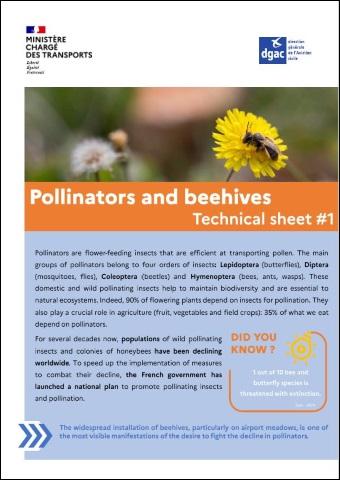Pollinators are floricultural (i.e. flower-feeding) insects that are efficient at transporting pollen. The main groups of pollinators belong to four insect orders: Lepidoptera (butterflies), Diptera (mosquitoes, flies), Coleoptera (beetles), and Hymenoptera (bees, ants, wasps).
These domestic and wild pollinating insects help maintain biodiversity and are essential to natural ecosystems. Indeed, 90% of flowering plants depend on insects for pollination. They also play a crucial role in agriculture (fruit, vegetables and field crops): 35% of what we eat depend on pollinators.
For several decades now, populations of wild pollinating insects and honeybee colonies have been declining worldwide. To speed up the implementation of measures to combat their decline, the French government has launched a national plan to promote pollinating insects and pollination.
The widespread installation of beehives, notably on airport meadows, is one of the most visible manifestations of the government's determination to combat the decline in pollinators.
CHALLENGES FOR BIODIVERSITY
The installation of beehives can have negative consequences for wild pollinators.
Increasing the number of beehives in airport meadows can put pressure on the availability of floral resources for wild pollinators. When these food resources are limited, indirect competitive interactions can occur between honey bees and wild pollinators. Colonies of honey bees can also be carriers of viruses or parasites for wild populations.
Furthermore, as honey bees are generalists, they visit a wide range of plant species and are therefore less efficient at sexually reproducing plants than wild pollinators, who are more specialized and therefore limit themselves to a smaller number of plant species.
Finally, competition can also arise between the hives themselves, each of which can contain tens of thousands of individuals who have to share floral resources.
TO REMEMBER
- Plan for a density of less than 3 hives/km2 and a distance of more than one kilometer between apiaries.
- Adapt the management of the platform: give priority to refuge strips and areas rich in melliferous plants.
- Give preference to local and wild flowers.
- Contact specialized associations.


| Editor | STAC |
|---|---|
| Publication year | 2025 |
| Format | A4 |
| Pages number | 2 |
